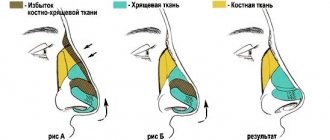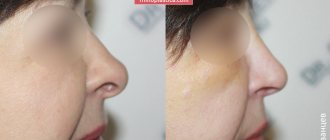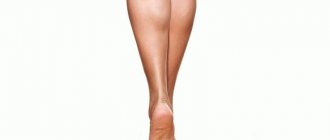It's one thing when the blush on your cheeks appears and quickly disappears, as, for example, after a winter walk. And it’s quite another thing if it spreads across the face, does not go away for a long time and is also complicated by various rashes on the skin. We learned more about such a disease as rosacea at the X National Congress “Plastic Surgery, Aesthetic Medicine and Cosmetology”.
At the congress, many issues of dermatology were raised, including diagnosis, mechanisms of development and treatment of rosacea (rosacea). In this article we present excerpts from the report of dermatologist, cosmetologist, doctor of medical sciences Elena Arabian, which will help to better understand what rosacea is, what factors can provoke the appearance of this disease and how it is treated today.
When to sound the alarm
The main symptoms for diagnosing rosacea are persistent erythema (redness of the skin), which usually appears in the central part of the face and lasts more than two months, and is also characterized by concomitant dilation of small vessels of the skin and the formation of inflammatory elements, rosacea.
Previously, rosacea was said to be a vascular disease of unknown etiology, and it can be triggered by many factors. “Now there is a completely definite evidence base that rosacea is a chronic inflammatory dermatosis,” says Elena Arabian.
Studies show that rosacea in our country is less common than diabetes, but more common than asthma and psoriasis. And, for example, in the USA every tenth patient comes to the clinic with symptoms of rosacea to a dermatologist.
Result
Such rhinoplasty without surgical intervention immediately changes the appearance for the better, and the final aesthetic effect can be seen after just a few days, when the false volume caused by swelling has completely disappeared. This minimally invasive method corrects a number of defects :
- depressions, irregularities and asymmetry;
- drooping, ugly upturned, too thin tip;
- the back is flat or with a hump;
- irregular shape of the bridge of the nose;
- scars, unaesthetic consequences of injuries and operations;
- saggy, flabby soft tissues.
In these cases, a targeted impact on the problem area allows you to avoid a more traumatic operation. If it is still necessary, the corrective procedure offered by the CONSTANTA Clinic, which is temporary, that is, reversible, will make it possible to see whether the surgical intervention will bring the desired aesthetic effect. Also, the technique should be used in cases where the operation is currently impossible due to medical contraindications or the patient has not reached the age of majority.
Effect duration
How long the corrective effect will last depends on:
- the selected drug;
- the nature of the problem being solved;
- individual characteristics of the patient's skin;
- his age and lifestyle.
The choice of a cosmetic product and the accuracy with which it will be introduced are determined by the professionalism of the doctor performing the manipulations. Qualified specialists of the CONSTANTA Clinic, who have undergone the necessary training and are fluent in the technique, will perform a procedure that guarantees the longest lasting effect. We use substances specifically designed for this purpose, which have proven their safety in a number of clinical trials and have received favorable reviews from our patients.
The average resorption time for fillers is 8-12 months. It depends on how quickly your body processes the received substances. Considering that the nose is the least mobile part of the face, this process, and therefore the resulting aesthetic effect, can last up to 2 years. This is much more effective than similar manipulations to eliminate wrinkles or enhance lips.
First roles
In recent years, it has been believed that the leading roles in the appearance of rosacea are played by innate immunity, microbiota and the inflammatory process. Innate immunity triggers the production of antimicrobial peptides and proinflammatory cytokines. “With rosacea, their levels increase sharply. For example, the activity of antimicrobial peptides cathelicidins increases 10 times, and the level of peptidase increases 10 thousand times! - continues Elena Arabian. — Flora also works in a special way. Staphylococcus is of great importance here, but the leading role is played by mites of the genus Demodex. Together with bacteria, fungi and viruses, they are a representative of the microbiome, but with rosacea their increased density is noted: it has been proven that they provoke inflammation. One of the reasons why this microscopic mite becomes pathogenic is low skin moisture.
Factors that provoke exacerbation of chronic rosacea are considered to be stress, extreme cold or heat, alcohol intake, hot and spicy foods. Recently, soy sauce and vanilla have been added to the list of food provocateurs. But coffee and drinks containing caffeine have been rehabilitated.
Concomitant diseases play a major role in the development of rosacea. First of all, we are talking about gastrointestinal problems, celiac disease, Crohn's disease, infection caused by Helicobacter pylori, irritable bowel syndrome - these are all background conditions. Recent studies have shown a connection with hypertension, cardiovascular pathology, anxiety disorders, depression and diabetes. Considering all these factors, it is clear that patients with rosacea require a multidisciplinary approach.”
Clinical symptoms of rosacea are redness of the skin, the appearance of telangiectasia (dilation of small vessels) and various rashes: papules, pustules, fimas (inflammatory elements, rosacea, bumpy formations).
Advantages and disadvantages of non-surgical rhinoplasty
Nose correction with fillers has an important advantage over classical plastic surgery - the procedure is reversible. Fillers dissolve after 9–20 months, and the nose regains its previous shape. The process can be accelerated by introducing a special enzyme - hyaluronidase. If desired, you can make the correction again.
The second significant advantage is the low invasiveness of the procedure. Injections take a minimum of time, and recovery takes 3 to 4 days. This cannot even be compared with rehabilitation after surgical rhinoplasty. No preparation is required either, and the list of contraindications is very short. No marks are left on the skin.
There is only one drawback to such an intervention - it will not be possible to radically change the shape of the nose and reduce its size.
Treatment algorithm
“Today, the understanding of the causes and mechanism of development of rosacea is different than 5-10, and even more so 20 years ago,” states Elena Arabianskaya, “therefore, the approach to treatment is different. The diagnosis is made on the basis of prolonged erythema and fim. Therapy depends on the clinical manifestations of the disease and the nature of the rash. For treatment, we already had good drugs: we had azelaic acid, metronidazole, but now topical ivermectin is becoming the leader. It gives a double effect. Its pronounced antiparasitic effect allows you to reduce the population of skin mites, but at the same time (which is very important) it has anti-inflammatory properties. This drug works great in the presence of inflammatory elements (papules, pustules), but redness may still remain. Therefore, it is recommended to act on receptors to blood vessels. For this purpose, brimonidine tartrate was used, which was used to treat some forms of glaucoma. It starts working in 30 minutes and wears off in 12 hours.”
Laboratory tests for microorganisms and demodex mites are not carried out for either acne or rosacea!
As for hardware techniques, so-called vascular lasers are relevant here. They not only have an anti-inflammatory effect, but also reduce the density of mites. Diode, alexandrite, neodymium lasers and broadband pulsed light (IPL) can be used for the same purpose.
Auxiliary methods of treating the disease are microcurrent therapy for lymphatic drainage, cryotherapy for vasoconstrictor and anti-inflammatory effects. Treatment of concomitant diseases also plays an important role. In general, combination therapy gives good results.
Features of the correction
The non-surgical procedure, thanks to local anesthesia, is painless, lasts no more than an hour, and rehabilitation after it takes only a few days. There is no need for serious restrictions, bed rest or hospital stay. One injection takes about 15 minutes. The volume of intervention and the injection site are determined by the doctor individually, taking into account the problems being solved. Preliminary consultations with a therapist, plastic surgeon and dermatologist will eliminate possible contraindications and help you choose the right type and dosage of the injected product.
The procedure at the CONSTANTA Clinic is performed on an outpatient basis in several stages :
- The nose and cheeks are cleaned with a disinfectant solution.
- A cream with an anesthetic is applied to the skin if the anesthetic component is not part of the antiseptic or corrective agent. Leave for 15 minutes until the anesthesia takes effect.
- A disposable syringe is filled with a drug to correct the shape of the nose and the product is slowly injected under the skin in the selected area. If necessary, the manipulation is repeated.
- After the sensitivity of the skin in the injection area is restored, the patient can go home.
Recovery period
After minimally invasive corrective manipulations in the nasal area, only slight swelling and slight redness at the injection site remain. They do not require special rehabilitation measures and go away on their own in a few days. During the recovery period, it is necessary to prevent injuries to the nose, which can lead to tissue displacement and leveling out the resulting effect.
Recommendations for patients during rehabilitation
- Immediately after the procedure, apply cold to the manipulation sites to prevent the formation of hematomas and reduce swelling.
- On the first day , avoid the use of decorative cosmetics and care products. Massage the corrected area for better distribution of the injected substances under the skin.
- In a day you can return to normal life.
- For two weeks, refrain from visiting the solarium, bathhouse and swimming in the pool.
Strengthen the barrier
“Another important point is the condition of the skin barrier,” continues Elena Arabian. — In patients with chronic rosacea, transepidermal water loss is very pronounced, which leads to increased inflammatory response, degradation of the intercellular matrix and collagen structures — this contributes to early skin aging. The vast majority of people suffering from rosacea have sensitive skin, so they need adequate daily skin care. These products are based on caffeine, which improves microcirculation, glycerretinic acid derivatives, which restore the skin barrier, and sun protection.
Indications and contraindications
Nose contouring is a cosmetic procedure; there are no medical indications for it. Injections help eliminate cosmetic defects:
Indications;
- Asymmetry;
- Humps;
- Lack of volume;
- Curvatures.
Contraindications are the same as for other types of contour plastic surgery:
- Autoimmune and oncological diseases;
- Exacerbation of chronic diseases, acute diseases;
- Rashes, dermatological diseases in the treatment area;
- Pregnancy, lactation;
- Tendency to form keloids;
- Blood clotting disorders.
Important: before the procedure, you should not drink alcohol or drugs that affect blood clotting.
What are the benefits of hyaluronic acid fillers?
- No side effects (allergic, toxic, etc.) to the drug due to its identity with the skin’s own hyaluronic acid;
- The drug is completely absorbed (from 6 to 15 months).
The drug Radiesse (calcium hydroxyapatite) has proven itself well. Its advantages: longer resorption time (2-3 years), less hydrophilic compared to hyaluronic acid preparations (in areas prone to swelling). The drugs differ in viscosity, hydrophilicity, stability and other parameters.
Non-surgical rhinoplasty: experts talk about the pros and cons of the procedure
Previously, those who wanted to change the shape of their nose went straight to the surgeon's office.
There were no other options. However, for some time now, cosmetologists have learned to use injectable preparations (for example, gels based on hyaluronic acid) to correct the profile in less than 15 minutes. We learned from the experts all the intricacies of non-surgical rhinoplasty. The American cosmetologist Alexander Rivkin is considered the inventor of the non-surgical rhinoplasty technique (he performed this procedure back in 2002), although hundreds of plastic surgeons and dermatologists now offer this service around the world. The before and after photos are so incredible that many people think they can change the shape of their nose during their lunch break. However, everything is not so simple.
How it works?
Most fillers provide a temporary effect (from three months to two years, depending on the type of drug chosen).
Many people do not understand why injections are necessary if the results are fleeting. For example, Volumema lasts for a year and a half. Once the drug dissolves, many move on to Bellafill (a collagen-based injection commonly used to treat acne scars). The effect after its introduction lasts for years, notes Alexander Rivkin.
Correction methods
Botulinum toxin injections
In people with developed nasal muscles, the tip of the nose usually drops down (the so-called “droopy” nose). Botulinum toxin relaxes facial muscles and blocks the appearance of wrinkles. Modern formulations of the drug are practically safe, but there are individual contraindications.
If there is drooping of the tip of the nose when smiling or talking, it would be better to inject botulinum toxin into the muscle that lifts the upper lip and the wing of the nose,
— comments the head of the anti-age department of the LazerJazz clinic, Aptos trainer, dermatologist-cosmetologist Marina Miusova.
Pros: there is no rehabilitation after the procedure, practically no contraindications. As a result, the correction is very delicate.
Cons: it is impossible to radically correct the shape of the nose.
Filler injections
If the bridge of the nose and the bridge of the nose are low, filler injections are a more effective and simple way to correct the shape.
Although injections are less traumatic (not like surgical correction!), after the injection of filler, its volume decreases due to biodegradation, so to maintain the effect, it is necessary to repeat the procedure periodically, says the expert.
Pros: low-traumatic, fast, effective when the bridge of the nose and bridge of the nose are low.
Disadvantages: with their help you cannot make the tip sharper, raise it, get rid of the hump and narrow the wide nose. You also need to repeat the procedure about once a year to maintain the effect.
There is complex blood circulation in the nose area, so a doctor’s mistake during the injection is fraught with edema, ischemic lesions on the skin and thrombosis of the vessels supplying the frontal part of the face and the nose itself.
Thread correction
Recently, methods of nose correction using threads have become very popular. With their help, you can significantly correct the shape of your nose: raise the tip and make it sharper, even out asymmetry, smooth out a hump, you can even visually shorten your nose. But this method also has its limits of what is possible - it is impossible to narrow the wings of the nose and remove the hump completely.
Pros: the procedure is fast, effective and safe, the results last a long time.
Cons: there is rehabilitation, bruising and swelling may occur.
Lipolitics
These drugs eliminate subcutaneous fat and intercellular fluid - it is their excess that gives the nose a massive appearance.
Pros: Helps make your nose look smaller.
Cons: the effect of lipolytics can spread to the cartilage structure and degenerate the “framework” of the nose. Such consequences will have to be corrected surgically.
Hormonal drugs
They destroy subcutaneous fat, affecting the cartilage and septum, which makes it possible to narrow the volume of the back, reduce the volume of the cartilaginous part and tip.
Plus: permanent results.
Cons: unfortunately, it is extremely difficult to predict the exact result. Uncontrolled metamorphosis can result in softening of the cartilage and blockage of blood vessels, followed by ischemia, which manifests itself as whitish spots at the injection sites.
Rehabilitation
If there was a pain scale, Botox would be at the bottom (you can barely feel the injections), cheek injections would be towards the top. Lip injections are somewhere in the middle. What about non-surgical rhinoplasty? All experts say it is almost painless. But some patients still choose to use a local anesthetic to numb the area. However, even ordinary ice helps.
Risks
The advantages of non-surgical plastic surgery are obvious: a “new” nose without anesthesia and a scalpel, fast rehabilitation and relatively low cost. But even seemingly safe methods have disadvantages. All injections are risky. Swelling, bruising, and bleeding may occur. The nose is a particularly delicate area of the face.
Procedures in the nasal area are considered the most dangerous because the blood supply to the nose is quite poor. This is not a procedure that can be done “on sale.” Before deciding on non-surgical rhinoplasty, you need to make sure that the doctor is competent and ask to be warned about all potential risks, the expert notes.
Plastic surgeons most often oppose this type of correction. They are sure that real rhinoplasty cannot be performed without surgery - surgical changes in the structures of the nose, work with bone and cartilage tissues, and mucous membranes. But cosmetologists, in their opinion, cannot do such things: surgical skills and knowledge of an ENT doctor are required.
Personally, I do not carry out such a procedure separately, but in exceptional situations I can use it after surgery as an auxiliary tool. For example, we performed rhinoplasty, but the back sagged and became slightly concave. In this case, you can inject a small part of the drug and thus raise it. When the drug dissolves, its own connective tissue will already form in that place and the back will stand up as it should. That is, in this case, the filler plays the role of a temporary fixative, but nothing more,” Otari Gogiberidze, leading plastic surgeon at the Time of Beauty clinic, explains his position.
According to the expert, it is not worth correcting the shape of the nose with injectable drugs on a regular basis.
Constant tissue trauma can lead to scarring. But, alas, this often happens: the patient changes the shape of the nose with the help of fillers, and after a few months everything resolves and correction is inevitably required, says Otari Gogiberidze.
The most dangerous thing, according to the surgeon, is when it is not drugs based on hyaluronic acid that are injected, but non-absorbable biopolymers. This can cause tissue thinning, necrosis and deformation of the nose. And in the end, you will still have to go to a plastic surgeon to correct the situation. But working with this will, of course, be more difficult than with an “untouched” nose.
Plastic surgeon Dmitry Skvortsov, winner of the Crystal Lotus 2019 award in the category “Best plastic surgeon for rhinoplasty,” also agrees with the previous expert.
Injection techniques are appropriate for correcting small defects, but only a plastic surgeon can predict and provide a lasting natural result. There is the so-called “conserving rhinoplasty” and, in particular, low-traumatic ultrasound correction of the nose using a piezotome. The volume, course and appropriate method of correction should be determined in detail in consultation with a qualified and experienced specialist,” he says.
Price
The average cost of rhinoplasty in Russia is 250 thousand rubles. Non-surgical rhinoplasty using Voluma gel will cost 60 thousand rubles per year. It cannot be said that the procedure saves money, but it is performed without general anesthesia and does not have irreversible changes.
The essence of the procedure
Nose contouring is used in cases of any minor defects in appearance. Often, such a service for improving the respiratory system is sought by patients for whom surgery seems too dangerous, or some simply want to try to fix their nose in order to undergo a full-fledged rhinoplasty in the future.
As a rule, the procedure is performed using local anesthesia and usually does not take much time, somewhere around an hour. The specialist injects a filler based on hyaluronic acid into the problem area. Thus, the filler creates a lifting or volume effect. The selection of filler is carried out by a specialist, based on your indications and the individual characteristics of the whole body.
Often, patients actively use this procedure in cases where they have the following aesthetic problems:
- Violation of the shape of the back of the nose - hump, asymmetry, flattening of the back, etc.
- Violation of the shape of the tip of the nose - a bifurcated tip or a drooping tip of the nose.
- Irregular shape of the wings of the nose - large lumen of the nostrils or asymmetry.
Recovery after non-surgical rhinoplasty takes a maximum of one day, during which time the slight swelling at the injection site will resolve on its own. The resulting effect after the procedure can be maintained for 6 to 12 months.







